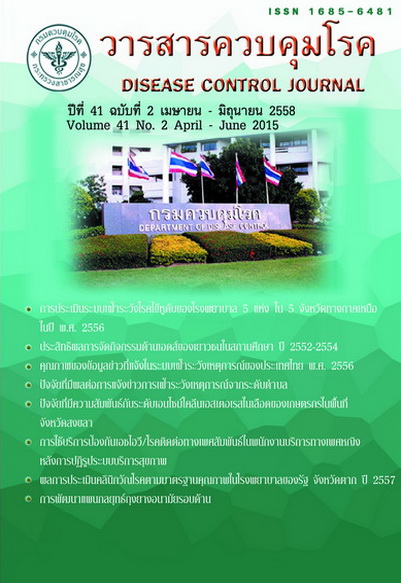Utilization of STI/HIV services in female sex workers after the health care reform
DOI:
https://doi.org/10.14456/dcj.2015.23Abstract
This study is to determine utilization of sexually transmitted infection (STI)/HIV services among female sex workers and associated factors after the health care reform particularly the transfer of STI clinics from the provincial health offices to hospitals. The survey was done in cities of Bangkok, Pattaya, Songkla and ChiangMai. Female sex workers were randomly selected with proportionally stratified to size of types of establishments and freelance. They were approached and asked for participation with verbal consent. Face to face interview with structured questionnaire was done by trained interviewers. Data were analyzed using descriptive and inferential analysis. 813 female sex workers were included for the study. The mean age was 28 years old (range 14-62 years) with 94.7% were Thai. There were 22.5% reported no health insurance, 68.6% were under universal coverage scheme (UHS) and 11.4% were UHS with registration in the working area. The median time working in sex work was 2 years. The median number of clients in the last month was 14. 67.1% of sex workers had ever used STI services while 60.1% used it in the last 12 months. 82.9% had ever got HIV testing and 68.8% did within the last 12 months. Sex workers in karaoke (52.1%), beer bars (54.3%), and freelance (63.3%) had used STI services less than those in ago go bars (80.3%), brothels (81.1%), and massage parlors (94.9%). FSW aged under 20 years was less likely to use STI services (43.1%). Those who entitled to the free health services were more likely to use STI services (79.6%). More efforts should be made to improve services for sex workers not only on STI and HIV but also on reproductive tract problems, alcohol, and drugs with particular focus on those who are younger age; did not entitle to the health benefits in the working area; and worked in context of karaoke, beer bars and freelance.
Downloads
References
2. Rojanapitayakom W. The 100% condom use programme in Asia. Reproductive Health Matters 2006;14:41-52.
3. United Nations Development Programme. Thailand's response to HIV/AIDS: progress and challenges. Bangkok: Keen Publishing; 2004.
4. กลุ่มโรคติดต่อทางเพศสัมพันธ์ สำนักโรคเอดส์ วัณโรค และโรคติดต่อทางเพศสัมพันธ์. รายงานประจำปีการควบคุมโรคติดต่อทางเพศสัมพันธ์ ปีงบประมาณ 2548. กรุงเทพมหานคร: โรงพิมพ์การศาสนา; 2006.
5. สำนักโรคเอดส์ วัณโรค และโรคติดต่อทางเพศสัมพันธ์. สถานบริการทางเพศและผู้ให้บริการทางเพศในประเทศไทย พ.ศ. 2549. กรุงเทพมหานคร: โรงพิมพ์การศาสนา; 2006.
6. World Health Organization. Review of the health sector response to HIV/AIDS in Thailand. India: WHO SEARO; 2005.
7. สำนักโรคเอดส์ วัณโรค และโรคติดต่อทางเพศสัมพันธ์. มาตรฐานการจัดบริการดูแลรักษา ป้องกันและควบคุมโรคติดต่อทางเพศสัมพันธ์ สำหรับสถานบริการสาธารณสุข. กรุงเทพมหานคร: โรงพิมพ์ชุมนุมสหกรณ์การเกษตร; 2008.
8. กองทุนประชากรแห่งสหประชาชาติ. รายงานทบทวนและสังเคราะห์สถานการณ์การป้องกันโรคติดต่อทางเพศสัมพันธ์และเอชไอวี ที่เกี่ยวข้องกับธุรกิจบริการทางเพศ. กรุงเทพมหานคร: UNFPA Thailand; 2008.
Downloads
Published
How to Cite
Issue
Section
License
Articles published in the Disease Control Journal are considered as academic work, research or analysis of the personal opinion of the authors, not the opinion of the Thailand Department of Disease Control or editorial team. The authors must be responsible for their articles.






